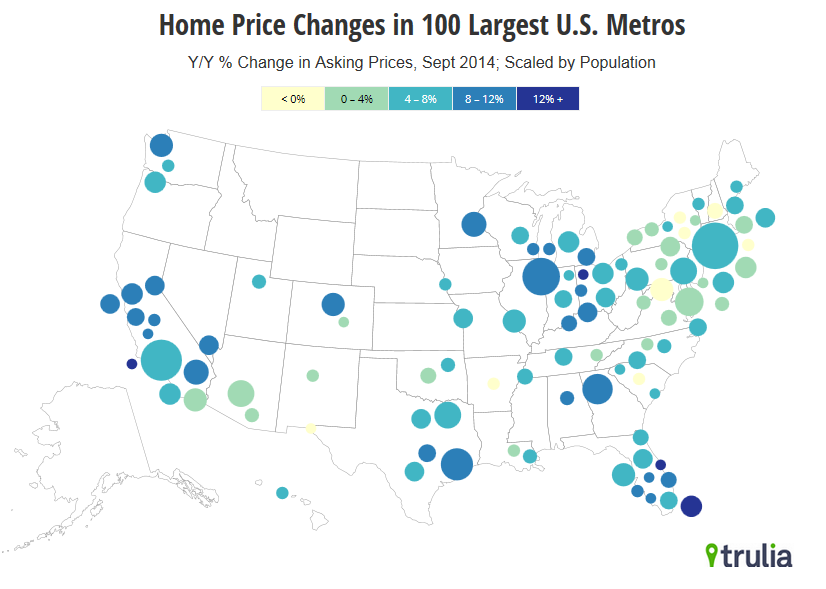Asking prices rose 7.3% year-over-year for condos versus 6.0% for single-family homes. Condo prices are up more than 15% in Miami, Denver, and West Palm Beach.
The Trulia Price Monitor and the Trulia Rent Monitor are the earliest leading indicators of housing price and rent trends nationally and locally. They adjust for the changing mix of listed homes and show what’s really happening to asking prices and rents. Asking prices lead sales prices by approximately two or more months. As a result, the Monitors reveal trends before other price indexes do. With that, here’s the scoop on where prices and rents are headed.
Prices Rose 0.8% Month-over-Month in September
Nationally, the month-over-month increase in asking home prices rose to 0.8% in September. Year-over-year, asking prices rose 6.4%, down from the 10.4% year-over-year increase in September 2013. Asking prices rose year-over-year in 92 of the 100 largest U.S. metros.
| September 2014 Trulia Price Monitor Summary | |||
| % change in asking prices | # of 100 largest metros with asking-price increases | % change in asking prices, excluding foreclosures | |
| Month-over-month,
seasonally adjusted |
0.8% | N/A | 0.8% |
| Quarter-over-quarter,
seasonally adjusted |
1.7% | 80 | 2.0% |
| Year-over-year | 6.4% | 92 | 5.9% |
| Data from previous months are revised each month, so data being reported now for previous months might differ from previously reported data. | |||
The South Leads in Price Gains
Five of the 10 U.S. metros with the largest year-over-year price increases were in the South, including Miami, Palm Bay-Melbourne-Titusville, West Palm Beach, Birmingham, and Atlanta.
These 10 metros include some markets where prices are speeding up and some where prices are slowing down. Prices are rising faster now than a year ago in Toledo, Birmingham, Miami, and several other metros. But in the two California metros where prices are rising the most – Ventura County and Oakland – as well as in Detroit and Atlanta, the past year’s price gains were actually slower than the previous year’s increases of 20% or more.
| Where Asking Prices Rose Most Year-over-Year, September 2014 | ||||
| # | U.S. Metro | Y-o-Y % asking price change, Sept 2014 | Y-o-Y % asking price change, Sept 2013 | Difference in price change, Sept 2014 vs Sept 2013 |
| 1 | Miami, FL | 14.0% | 9.3% | 4.7% |
| 2 | Palm Bay–Melbourne–Titusville, FL | 13.1% | 6.7% | 6.4% |
| 3 | Toledo, OH | 12.5% | 1.6% | 10.9% |
| 4 | Ventura County, CA | 12.4% | 20.2% | -7.7% |
| 5 | Oakland, CA | 11.9% | 28.7% | -16.8% |
| 6 | West Palm Beach, FL | 11.7% | 6.0% | 5.8% |
| 7 | Birmingham, AL | 11.5% | 1.8% | 9.7% |
| 8 | Detroit, MI | 11.4% | 20.0% | -8.6% |
| 9 | Lake County-Kenosha County, IL-WI | 11.3% | 8.6% | 2.7% |
| 10 | Atlanta, GA | 11.1% | 20.9% | -9.7% |
| Note: among 100 largest metros. To download the list of asking home price changes for the largest metros: Excel or PDF | ||||

Condo Prices Rising Faster than Single-Family Home Prices
Nationally, asking prices for condos – by which we mean all for-sale homes in multi-unit buildings — rose 7.3% year-over-year. That’s more than the 6.0% increase for single-family homes. Asking prices for condos rose more than 15% year-over-year in Miami, Denver, and West Palm Beach. Condo prices rose faster than single-family home prices in 18 of the nation’s 20 largest condo markets.
Although condo prices are outpacing single-family home prices, they are following similar patterns. Condo prices and single-family home prices are both rising faster in metros with stronger job growth and those that had a more severe housing bust in the past decade (a bounceback due to the “rebound effect”). In fact, metros with bigger condo price increases also tend to have bigger single-family home price increases.
| Condo and Single-Family Home Prices in the 20 Largest Condo Markets | |||
| # | U.S. Metro | Y-o-Y % change in asking prices for condos, Sept 2014 | Y-o-Y % change in asking prices for single-family homes, Sept 2014 |
| 1 | Miami, FL | 17.0% | 11.7% |
| 2 | Denver, CO | 15.5% | 8.2% |
| 3 | West Palm Beach, FL | 15.2% | 9.5% |
| 4 | San Francisco, CA | 12.7% | 9.0% |
| 5 | Chicago, IL | 10.9% | 8.6% |
| 6 | Middlesex County, MA | 10.4% | 6.5% |
| 7 | Minneapolis–St. Paul, MN-WI | 10.0% | 10.1% |
| 8 | Boston, MA | 9.6% | 2.4% |
| 9 | Seattle, WA | 9.4% | 8.5% |
| 10 | Tampa–St. Petersburg, FL | 9.1% | 4.1% |
| 11 | Los Angeles, CA | 8.7% | 6.8% |
| 12 | Fort Lauderdale, FL | 8.2% | 5.2% |
| 13 | Philadelphia, PA | 6.0% | 3.3% |
| 14 | Honolulu, HI | 5.7% | 3.5% |
| 15 | New York, NY-NJ | 5.0% | 4.0% |
| 16 | Washington, DC-VA-MD-WV | 4.9% | 2.5% |
| 17 | Newark, NJ-PA | 4.2% | 1.0% |
| 18 | San Diego, CA | 4.1% | 1.8% |
| 19 | Long Island, NY | 3.9% | 2.6% |
| 20 | Providence, RI-MA | 2.0% | 3.0% |
| Note: condos refer to all for-sale units in multi-unit buildings. The 20 largest condo markets were determined based on Census data. | |||
Rents Rising Faster for Apartments Than for Single-Family Homes
Nationally, rents rose 6.5% year-over-year in September. Apartment rents were up 6.9%, while single-family home rents gained 5.2%. Like the for-sale market, the rental market is tighter for multi-unit buildings than for single family homes. Census data show that the multi-unit vacancy rate has been falling steadily, but remains elevated for single-family homes. Despite the multi-unit construction boom, the cost of living in these buildings is rising faster than in single-family homes – both for renters and buyers. This is not necessarily a sign of a permanent shift toward city living. But it certainly reflects a reversal from the past decade’s bubble, when demand was strong for single-family homes in the suburbs and beyond.
| Rent Trends in the 25 Largest Rental Markets | |||
| # | U.S. Metro | Y-o-Y % change in rents, Sept 2014 | Median rent for 2-bedroom, Sept 2014 |
| 1 | San Francisco, CA | 15.5% | 3600 |
| 2 | Oakland, CA | 14.2% | 2600 |
| 3 | Denver, CO | 13.7% | 1550 |
| 4 | Sacramento, CA | 13.3% | 1250 |
| 5 | Seattle, WA | 9.4% | 1800 |
| 6 | Los Angeles, CA | 9.0% | 2550 |
| 7 | Phoenix, AZ | 8.8% | 1050 |
| 8 | Philadelphia, PA | 8.7% | 1600 |
| 9 | Miami, FL | 8.5% | 2450 |
| 10 | Baltimore, MD | 8.3% | 1600 |
| 11 | New York, NY-NJ | 7.8% | 3500 |
| 12 | Atlanta, GA | 7.1% | 1250 |
| 13 | Chicago, IL | 7.0% | 1650 |
| 14 | Riverside–San Bernardino, CA | 6.3% | 1550 |
| 15 | Tampa–St. Petersburg, FL | 6.2% | 1150 |
| 16 | St. Louis, MO-IL | 6.2% | 950 |
| 17 | San Diego, CA | 6.0% | 2000 |
| 18 | Orange County, CA | 6.0% | 2100 |
| 19 | Las Vegas, NV | 5.9% | 1000 |
| 20 | Dallas, TX | 5.2% | 1400 |
| 21 | Houston, TX | 5.1% | 1500 |
| 22 | Portland, OR-WA | 4.7% | 1300 |
| 23 | Boston, MA | 4.4% | 2350 |
| 24 | Washington, DC-VA-MD-WV | 4.2% | 2200 |
| 25 | Minneapolis–St. Paul, MN-WI | 0.6% | 1300 |
The next Trulia Price Monitor and Trulia Rent Monitor will be released on Thursday, November 6.
How did we put this report together? The Trulia Price Monitor and the Trulia Rent Monitor track asking home prices and rents on a monthly basis, adjusting for the changing composition of listed homes, including foreclosures provided by RealtyTrac. The Trulia Price Monitor also accounts for regular seasonal fluctuations in asking prices in order to reveal underlying price trends. The Monitors can detect price movements at least three months before the major sales-price indexes do. Historical data are revised monthly. Thus, historical data presented in the current release are the best comparison with current data. Our FAQs provide the technical details.

